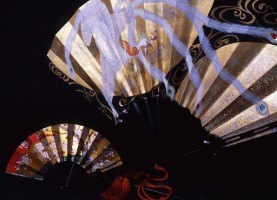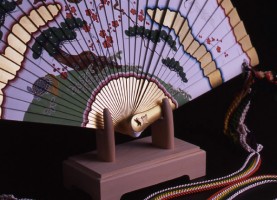

扇子は、日本で生まれ中国やヨーロッパにまで伝わった工芸品です。京都はその発祥の地だといわれています。平安時代初期(9 世紀頃)からつくられはじめ、16 世紀頃には現在のような技法が確立されました。茶道、香道、舞踊などの文化が花開いた京都だからこそ発達した工芸品だといえます。 京 扇子には非常に多くの種類があり、形状、素材など用途に応じた美のかたちが追求されています。木板を束ねた板 扇 と竹を骨にして紙や絹を貼った貼 扇 とに大別されます。
Folding fans were born in Japan, most likely in Kyoto, and travelled from there to China and Europe. Although first made around the 9th century in the early Heian Period, the techniques used today were developed around the 16th century. As the home of such traditional arts as the tea ceremony, incense ceremony and Japanese buyo dance, Kyoto was ideal for the development of this craft. Made in an amazing variety of forms, Kyoto folding fans are crafted with the shape and materials selected according to the application. They are broadly classified as ita-ogi, made from linked wooden ribs, and hariogi, made from paper or silk glued to bamboo or other ribs.
スケールの大きな扇面に描かれた鳳凰
末広がりのめでたい大扇
A Chinese phoenix is painted on the broad surface of this great,
auspicious fan.
平安王朝の雅を伝える、
日本最古の扇のかたち、檜扇
Delivering the elegance of the Heian court,
these cypress fans are the oldest style to be found in Japan.




